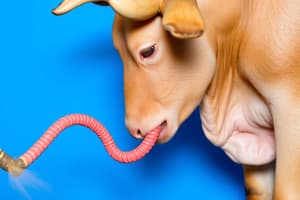Podcast
Questions and Answers
What is the role of bacteria and other microbes in the intestines of animals and insects?
What is the role of bacteria and other microbes in the intestines of animals and insects?
- They produce harmful toxins
- They digest nutrients and produce vitamins and growth factors (correct)
- They breakdown proteins into amino acids
- They absorb vitamins and growth factors
Where do bacteria and other microbes digest nutrients and produce vitamins and growth factors?
Where do bacteria and other microbes digest nutrients and produce vitamins and growth factors?
- In the kidneys of animals
- In the liver of animals
- In the intestines of animals and insects (correct)
- In the stomach of animals
What is a result of the digestion of nutrients by bacteria and other microbes in the intestines of animals and insects?
What is a result of the digestion of nutrients by bacteria and other microbes in the intestines of animals and insects?
- Absorption of minerals
- Breakdown of proteins into amino acids
- Production of harmful toxins
- Production of vitamins and growth factors (correct)
What is the relationship between bacteria and other microbes and animals and insects?
What is the relationship between bacteria and other microbes and animals and insects?
What is the primary function of bacteria and other microbes in the intestines of animals and insects?
What is the primary function of bacteria and other microbes in the intestines of animals and insects?
What kind of oxygen requirement does a microaerophile have?
What kind of oxygen requirement does a microaerophile have?
What happens to a microaerophile if it is exposed to normal atmospheric oxygen levels?
What happens to a microaerophile if it is exposed to normal atmospheric oxygen levels?
How would you describe the oxygen requirements of a microaerophile?
How would you describe the oxygen requirements of a microaerophile?
What can be said about the oxygen tolerance of a microaerophile?
What can be said about the oxygen tolerance of a microaerophile?
What is a characteristic of microaerophiles in terms of their oxygen requirement?
What is a characteristic of microaerophiles in terms of their oxygen requirement?
What is the shape of most animal viruses?
What is the shape of most animal viruses?
What type of viruses infect bacteria?
What type of viruses infect bacteria?
What is unique about the capsid of bacteriophages?
What is unique about the capsid of bacteriophages?
What is a characteristic of complex viruses?
What is a characteristic of complex viruses?
What type of symmetry do most animal viruses exhibit?
What type of symmetry do most animal viruses exhibit?
What is required for viral multiplication?
What is required for viral multiplication?
What is necessary for a virus to multiply?
What is necessary for a virus to multiply?
In which of the following is viral multiplication possible?
In which of the following is viral multiplication possible?
What is essential for the multiplication of a virus?
What is essential for the multiplication of a virus?
Where does viral multiplication take place?
Where does viral multiplication take place?
What are the distinct phases of microbial growth curve when bacteria are grown in a broth?
What are the distinct phases of microbial growth curve when bacteria are grown in a broth?
What is the synonyms of exponential phase?
What is the synonyms of exponential phase?
How many phases are there in the microbial growth curve?
How many phases are there in the microbial growth curve?
What comes after the log phase?
What comes after the log phase?
What is the first phase of microbial growth curve?
What is the first phase of microbial growth curve?





